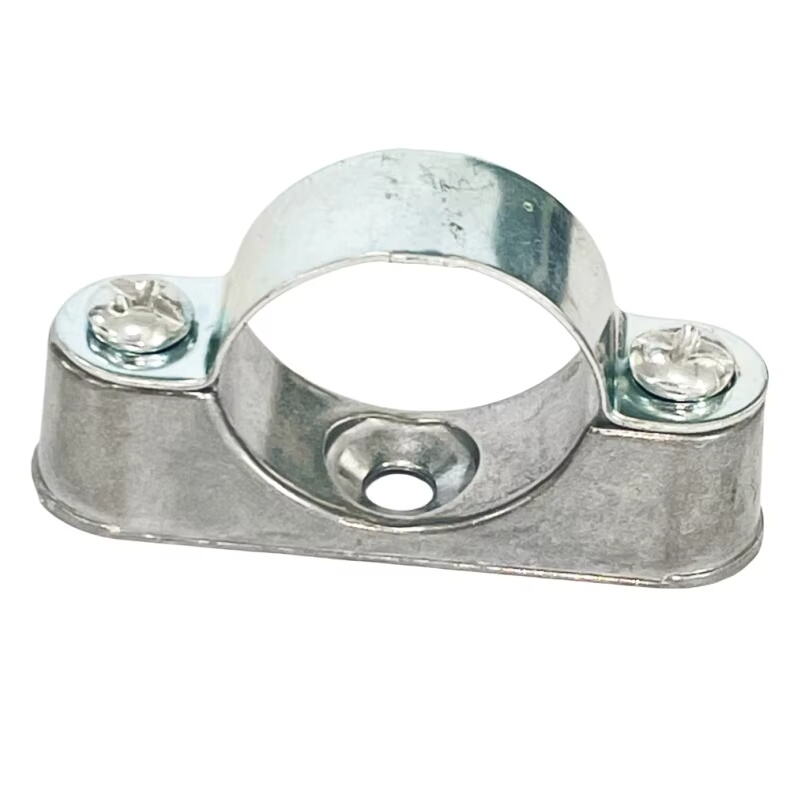Understanding Stainless Steel Hose Clamps
What Are Stainless Steel Hose Clamps?
Stainless steel hose clamps serve as those essential fasteners that keep hoses firmly attached to their fittings. These little devices create that crucial tight seal we all need to stop those annoying leaks. Made from actual stainless steel, they can take a beating without rusting away or breaking down, which is why plumbers, mechanics, and factory workers rely on them so much. When installed properly, the clamp wraps around the hose and then gets tightened down until it grips just right. What makes these clamps stand out? Well, nobody wants to deal with a failed connection when water's flowing at high pressure or when working on a car engine. That's where the real value comes in for anyone needing dependable performance day after day.
Key Benefits of Stainless Steel Construction
The benefits of stainless steel construction are manifold, contributing significantly to the performance of hose clamps in various applications.
Enhanced Durability: Stainless steel offers robust durability, outperforming alternatives like plastic or coated steel, ensuring a lasting lifespan.
Corrosion Resistance: It excels in wet or high-humidity environments, such as marine applications, where other materials might fail.
Mechanical Strength: Boasting strong mechanical properties, stainless steel supports better performance under high-pressure conditions.
Eco-Friendliness: With its recyclable nature, stainless steel is an eco-conscious choice that aligns with sustainability goals.
Industry Compliance: Compliance with industry standards assures safety and reliability in use, making it a preferred choice for professionals.
The comprehensive advantages of stainless steel contribute to its widespread adoption across different sectors, ensuring both efficiency and longevity in applications requiring secure clamps.
Types of Stainless Steel Hose Clamps
Worm Gear Clamps: Versatility and Adjustability
Worm gear clamps really stand out because they can be adjusted so easily, which makes these little devices pretty handy across many different situations. What makes them work so well is basically a metal band wrapped tightly around a screw mechanism that lets someone tighten or loosen things quickly while still getting a good grip on whatever hose needs securing. Because of how flexible this design actually is, mechanics working on cars will find them just as useful as plumbers fixing leaks at home. Most hardware stores carry several sizes too, so whether dealing with small garden hoses or larger industrial pipes, there's usually something that fits right. That kind of adaptability explains why so many tradespeople keep coming back to worm gear clamps again and again despite all the newer alternatives out there.
T-Bolt Clamps: Heavy-Duty Performance
T bolt clamps stand up to tough conditions in high pressure situations, giving a solid hold on bigger hoses without slipping or failing. What makes them special is how the T shaped bolt spreads out the pressure across the entire hose surface area. This helps prevent those annoying leaks we all hate and actually works better than many other types of clamps. People working in auto repair shops or manufacturing plants find these especially useful since they deal with all sorts of harsh conditions daily. These clamps can handle serious pressure levels too, making them go-to solutions when someone needs something that won't let go under stress.
Constant Torque Clamps for High-Pressure Systems
Torque clamps that maintain constant pressure provide real reliability in systems under high stress because they adjust automatically as pressure levels or temperatures change over time. What makes these clamps so good at their job is that they keep everything tight and secure even when things get unpredictable. That's why many folks in farming equipment and car manufacturing rely on them heavily. The way these clamps are built means they can handle all sorts of weather shifts without losing grip, which is something regular clamps just can't do. Anyone working with machinery knows how frustrating it gets when parts start coming loose unexpectedly. For this reason, constant torque models have become essential tools wherever maintaining steady pressure matters most for getting the job done right.

Choosing the Right Grade: 304 vs. 316 Stainless Steel
304 Stainless Steel: Ideal for General Use
When it comes to hose clamps, 304 stainless steel remains a go-to material because it stands up well against rust and is easy enough to shape during installation. The stuff holds together pretty well while still bending around curves, plus it doesn't cost an arm and a leg compared to other options on the market. We see these clamps everywhere really—from keeping things tight in meatpacking plants where moisture is always hanging around, all the way down to residential plumbing jobs where water pressure can get pretty aggressive sometimes. What makes this particular grade so versatile? Well, manufacturers across different sectors rely on them since they provide good grip without slipping loose over time, which matters when dealing with fluids under pressure. And let's face it, nobody wants to replace their clamps every few months just because something cheaper corroded away. That combination of decent price tag and reliable performance keeps 304 stainless steel at the top of most people's lists when looking for standard hose clamp solutions.
316 Stainless Steel: Superior Corrosion Resistance
When dealing with tough conditions that can wear down regular materials, most professionals turn to 316 stainless steel. What sets this grade apart is the inclusion of molybdenum, something that really boosts how well it stands up against chlorides and those nasty corrosive substances we all know too well. Because of this special ingredient, 316 stainless steel hose clamps have become go-to solutions for anyone working near saltwater or handling industrial chemicals regularly. Sure, these parts cost more upfront than standard 304 options, but over time they actually save money since there's less need for constant repairs or replacements. Anyone who's spent time on boats or in chemical plants will tell you that going with 316 means fewer headaches when things get wet or corrosive, making it worth every penny in the long run for critical operations.
When picking out a stainless steel grade, it's important to match it with what the particular application demands. Environmental conditions, budget considerations, and how much maintenance will be needed over time all play a role in this decision. For instance, someone working in a food processing facility might need different specs compared to someone dealing with harsh chemicals where corrosion resistance matters most. Getting familiar with these differences helps point people in the direction of selecting appropriate stainless steel grades for their hose clamps without getting overwhelmed by technical details.
Key Factors for Selecting the Best Clamp
Assessing Hose Diameter and Pressure Requirements
Picking out the right clamp means looking at both the hose diameter and what kind of pressure it needs to handle. Hose size matters a lot actually. If the clamp is too tight, it might actually tear the hose material over time. But if it's too loose? Well that just invites leaks and all sorts of problems down the line. Getting a proper fit keeps everything connected securely while avoiding those dangerous situations nobody wants. And don't forget about pressure ratings either. The clamp needs to be rated for at least the same pressure level as the hose itself, maybe even higher. This becomes really important when working with systems that run under high pressure. A good quality clamp won't give way when things get tough, which is exactly why professionals always check these specs before installation.
Environmental Considerations: Temperature and Chemical Exposure
When picking out clamp materials, environmental factors matter quite a bit. Temperature changes and chemical contact are big considerations for anyone working with industrial equipment. A clamp exposed to extreme heat or corrosive substances needs special materials to hold up under stress. Take stainless steel for example different grades handle wear and tear differently, some lasting years while others start failing after just months of service. Understanding what kind of environment the clamp will face helps ensure it lasts longer and keeps the hose system running smoothly. Good material selection based on actual operating conditions makes all the difference in day to day reliability.
Installation and Maintenance Best Practices
Proper Tightening Techniques to Avoid Damage
Getting the tightness just right makes all the difference when working with hose clamps. A good torque wrench lets workers apply pressure properly without messing up the hose itself. These wrenches let folks hit those exact numbers manufacturers recommend for their products. If someone goes too far with the tightening, the hose might actually bend out of shape or snap completely. On the flip side, not tightening enough means fluid will start leaking somewhere it shouldn't be going. Always check what the maker says about how tight things need to be. Most people forget that we're trying to create a solid connection here but don't want to crush the hose either. Look at the clamp after installation - if it looks warped or squashed, something went wrong during the process.
Regular Inspection and Cleaning Tips
Keeping an eye on hose clamps through routine inspections is really important for their ongoing performance. When we check them regularly, we can spot early signs of wear and damage before they become serious problems with the seals. Cleaning these clamps properly matters too. Using the right cleaning solutions helps stop dirt and grime from building up, which eventually causes corrosion issues down the road. Setting up a good maintenance schedule does double duty it extends how long those clamps last while making sure the whole system works reliably day after day. Taking care of these components consistently stops surprise breakdowns and gives us time to plan when parts need replacing or adjusting. This kind of proactive approach keeps everything running smoothly without unnecessary downtime or wasted resources.
FAQ
What factors should I consider when choosing a stainless steel hose clamp?
Consider the hose diameter, pressure requirements, and environmental conditions, such as temperature and chemical exposure, to ensure you choose the right type and grade of stainless steel clamp.
How do I maintain and ensure the longevity of stainless steel hose clamps?
Regular inspection, proper cleaning, and utilizing correct tightening techniques are crucial to maintain their performance and longevity.
Why are stainless steel hose clamps preferred over other materials?
They offer superior corrosion resistance, mechanical strength, and durability, making them suitable for a variety of demanding applications.

